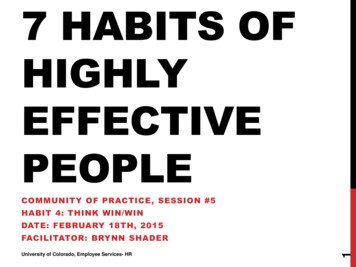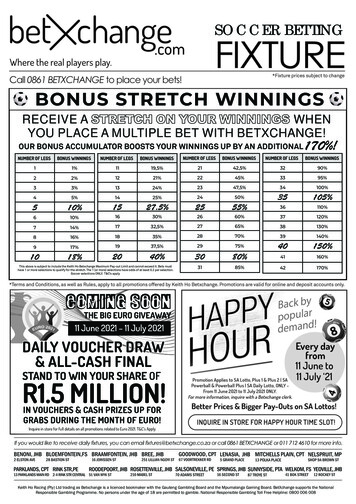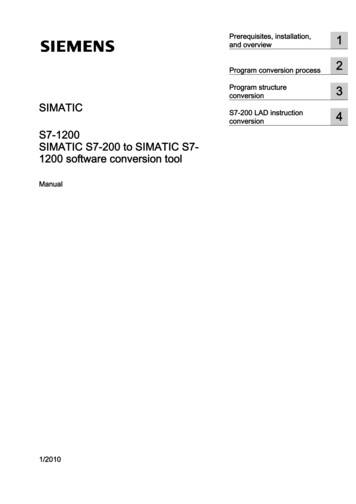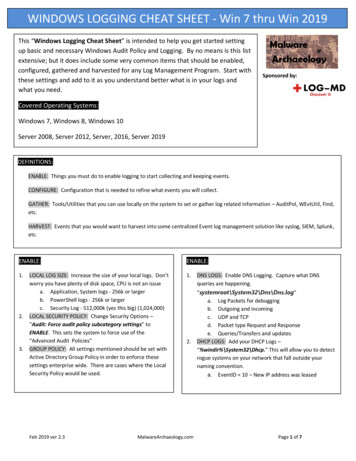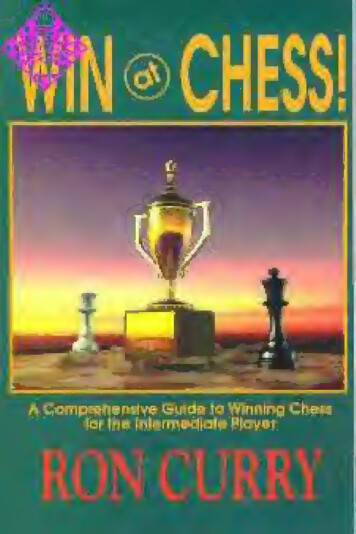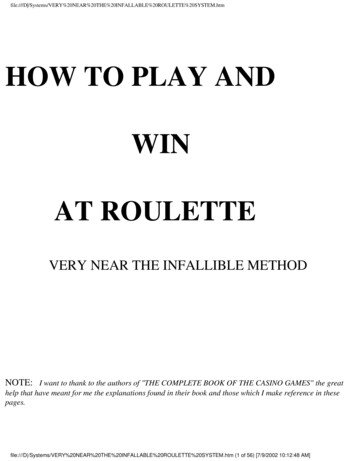
Transcription
file:///D %20SYSTEM.htmHOW TO PLAY ANDWINAT ROULETTEVERY NEAR THE INFALLIBLE METHODNOTE: I want to thank to the authors of "THE COMPLETE BOOK OF THE CASINO GAMES" the greathelp that have meant for me the explanations found in their book and those which I make reference in thesepages.file:///D %20SYSTEM.htm (1 of 56) [7/9/2002 10:12:48 AM]
file:///D %20SYSTEM.htmINDEX:INTRODUCTION.THE FIGURES.VERY NEAR THE INFALLIBLE METHOD.file:///D %20SYSTEM.htm (2 of 56) [7/9/2002 10:12:48 AM]
file:///D %20SYSTEM.htmINTRODUCTION.This book is directed to the player of roulette. To the player that knows already basicallythe operation of the game. To the player that has proven other methods without success.And lack to him two very important things, a book that explain to him that what happensreally in the roulette, and a method that to give him some high guarantees of success in thegame.All we have read some book that fills pages and more pages on the theories of the randomand the probabilities calculation without a subsequent practical application, and also wehave proven methods "miraculous" that though make to win money when the situation isfavorable do not notify of the dangers of an unfavorable situation, neither explain howsurpassing it. These situations are presented more often than what we think and we wish.Precisely by these reasons I will not extend in theoretical explanations. I will limit me toexplain some indispensable basic notions to understand on that base has been built themethod and below we will put in practice its game mechanism on real game sequences.file:///D %20SYSTEM.htm (3 of 56) [7/9/2002 10:12:48 AM]
file:///D %20SYSTEM.htmTHE FIGURES.(developed according to explanation from the book "THE COMPLETE BOOK OFTHE CASINO GAMES").What are the figures?. For the purpose of the simple combinations of the roulette, anumber anyone can be PAR or ODD, LACK or PASSES, RED or BLACK. We will centerin this last combination.We have two columns to note the combination of each play. If the number is red we makean annotation in the cabin of the left and if it is black in the right cabin. Each play canhave an alone annotation, or to the right or to the left, and it is one of the two possiblealternatives: RED or BLACK. It is said that the possible figures of 1 (of one play) are 2.In the second consecutive play the possibilities are: RED - RED, RED -BLACK, BLACK file:///D %20SYSTEM.htm (4 of 56) [7/9/2002 10:12:48 AM]
file:///D %20SYSTEM.htmRED, BLACK - BLACK, and is said that the figures of 2 are 4. In 3 consecutive plays thepossibilities are 8 (fig. 1).GRAPHIC1R BR BR BR BR BR BR BR BThe possibility of the fact that is formed a figure of 3 (1 between 8) is the half of be formeda figure of 2 (1 between 4) and the fourth part that a figure of 1 (1 between 2). Is the sameas to say:So that could be formed one figure of 2 those of 1 will have been able to form 2 times eachone, and so that could be formed one figure of 3 those of 2 will have been able to form also2 times, and thus successive. For so much, we can say that the figures of 1 are the doublethat those of 2, the figures of 2 are the double that those of 3, the figures of 3 are the doublethat those of 4, the figures of 4 are the double that those of 5, etc.This reasoning can be applied to the series saying that the series of 1 are the double thatthose of 2, the series of 2 are the double that those of 3, the series of 3 are the double thatthose of 4, etc.Evidently this ideal distribution is not fulfilled, and we can only assert is that while goesincreasing the number of plays, the distribution will be gone approximating every time moreto this ideal distribution. It can be that never it is fulfilled exactly, but the differencebetween the percentage that would correspond to every series taking into account thenumber of plays and the real will be every time smaller.file:///D %20SYSTEM.htm (5 of 56) [7/9/2002 10:12:48 AM]
file:///D %20SYSTEM.htmThe ideal distribution of the series in 247 plays would be this:SERIES1 series of 72 series of 64 series of 5.8 series of 4.16 series of 3.32 series of 2.64 series of 1.TOTAL127 series.PLAY %7 plays12 plays20 “32 “48 “64 “64 “0.781.573.156.3012.5925.1950.39247 plays.100.00If we go increasing the number of plays the corresponding percentage to the series of 1 goesapproximating to 50%, that of the series of 2 to 25%, that of the series of 3 to 12,5%, etc.file:///D %20SYSTEM.htm (6 of 56) [7/9/2002 10:12:48 AM]
file:///D %20SYSTEM.htmVERY NEAR THE INFALLIBLE METHOD.In the book "THE COMPLETE BOOK OF CASINO GAMES" the authors explain amethod used by a Spanish systemist called García. Taking this method, that we willexplain below, as a starting point, the authors elaborate their own system. We will not gointo to analyse the efficiency or mathematical base of this last, but we consider its practicalapplication excessivelycomplex. We also take it as a starting point, but to arrive, as we will see later, at quitedifferent results. GARCIA’s system consisted of the following:If the first play is BLACK, in the following one you bet 1 chip on the break of the series,that is to say, on RED. If the second play is RED you win 1 chip and you restart betting 1chip on BLACK.GRAPHIC2PLAYRBBET12RESULT1TOTAL011If the second play has not been RED but BLACK, you bet 3 chips on RED. If the third playis RED you get 2 chips (3 won minus 1 lost in the first play) and you restart betting 1 chipon BLACK.GRAPHIC3PLAYRBBETRESULTTOTALfile:///D %20SYSTEM.htm (7 of 56) [7/9/2002 10:12:48 AM]
file:///D %20SYSTEM.htm123130-12-13If the third play has been BLACK you bet 7 chips on RED. If the fourth play is RED youget 3 chips (7 won minus 4 lost) and you restart betting 1 chip on 37If the fourth play is BLACK, you don’t bet more on the break of the series. We’ve had aseries of 4. The system expects a series of 7, that is to say, 3 more BLACK. So far the lossesamount to 11 units, divided into 3 bets (4, 4 and 11Fifth play: you bet the first 4 units on BLACK. If the fifth play is in fact a BLACK, youbet the following 4 units on BLACK in the sixth play. If you also win then you bet the last3 units on BLACK in the seventh play. If the game has gone by in this manner you havefile:///D %20SYSTEM.htm (8 of 56) [7/9/2002 10:12:49 AM]
file:///D %20SYSTEM.htmobtained as net profits all the ones originated by the series of 1, of 2 and of 3 that haveappeared until -74430-1-4-11-7-30However, when one of the recovery bets of the plays 5, 6 or 7 fails, this loss is added to theone which still has to be recovered and we restart the cycle betting a unit on theintermittence, 3 units on the break of the series of 2 and 7 on the break of the series of 3,until a series of 4 appears again.GRAPHIC7BANK OF LOSSESPLAYRBBETRESULT PROFITST. LOSSES BET 1BET 2BET 31file:///D %20SYSTEM.htm (9 of 56) [7/9/2002 10:12:49 AM]
file:///D 4438BANK OF LOSSESPLAYRBBETRESULT PROFITST. LOSSES BET 1123451374-1-3-74-1-4-11-711764-4-1111BET 244BET 34330GRAPHIC9BANK OF LOSSESPLAYRBBETRESULT PROFITST. LOSSES BET 112345613744-1-3-744-1-4-11-7-3117373-3-66BET 2443BET 3430300An example, the game goes by with the profits obtained with the series from 1, 2 and 3 untila series of 4 appears. The loss amounts to 11 units. In the following play you bet 4 chipsfile:///D %20SYSTEM.htm (10 of 56) [7/9/2002 10:12:49 AM]
file:///D %20SYSTEM.htmon the formation of a series of 5 and you lost. These 4 chips are added to the previous 11that amount to a total of 15. The cycle restarts, until a series of 4 appears that will entailanother loss of 11 units. This loss will have to be added to the already existing of 15,amounting a total of 26, that will be divided in 3 (9, 9 and 8). In the fifth play we wouldbet 9 chips on the continuation of the series.GRAPHIC10BANK OF 526RBBETRESULT -90T. LOSSES BET 1BET 2BET 3-11-15443-2617999880file:///D %20SYSTEM.htm (11 of 56) [7/9/2002 10:12:49 AM]
file:///D %20SYSTEM.htm272829989891780800000As we can see, all the system is based on the appearance of a series of 7 or higher. Weknow that a series of 7 has a possibility of being formed every 247 plays and we have seenthat in a sufficiently large number of plays this prediction is true. But, obviously, this factdoes not occur regularly and in the same way that we can have 3 series of more than 6 in asequence of 30 plays, we can also find ourselves having to wait 300 plays until oneappears. What are the average losses that you may have to assume waiting for the series of7?Working always on the ideal distribution that we know and taking into account that a seriesof 4 causes that the deficit increases in 11 units more the third part of the already existingone, that a series of 5 does not alter the deficit and that a series of 6 reduces it 2/3 parts, wehave to assume losses of around 330 chips with recovery bets of 110. The deficit is notreally real since we would have been collecting the profits obtained with the appearance ofthe series from 1, 2 and 3, and they would be exactly 176 units. Summarising, we wouldhave an effective deficit of 154 chips and to recover we would have to make bets of 110.All this supposing that every two series of 4 it appears one of 5, and for every two series of5, one of 6. What does this system require to put it into practice? Two principalrequirements, first to have a great capital and second to have nerves of steel to apply it inthe game table with real money. But neither of these two requirements would be enough toguarantee the usefulness of the system. The time could arrive, and in fact we have seen itourselves several times during the tests we made, where the recovery bets surpassed themaximum bet allowed by the table (540 times the minimal bet). And we have also to takeinto account the appearance of the zero. This factor is the more important the higher thequantities which we can be forced to bet following the system.file:///D %20SYSTEM.htm (12 of 56) [7/9/2002 10:12:50 AM]
file:///D %20SYSTEM.htm2 OBSERVATIONS:1) It is a very risky system one that bases all the recovery on a fact that occurs once every247 plays.2) Setting aside its mathematical possibilities, the system was not making the most of theappearance of the series of 1, 2 and 3. García obtained 1 chip of profit with the series of 1,2 chips with the series of 2 and 3 chips with the series of 3. But if we apply the progression3 - 5 - 9, the series of one would produce 3 chips of profit, the series of 2 two, and the seriesof three 1 chip. The loss caused by a series of 4 would be of 17 units instead of 11.Obviously, the deficit would increase more quickly, but the system is based on recoveringall the losses with the first series of 7 or higher. When the series appears, after the usual 247plays, the profits obtained with Garcia’s system with the series of 1, 2 and 3 are of 176 unitsand with our progression they would amount to 272.GRAPHIC 11PLAYR12BBETRESULT1TOTAL11file:///D %20SYSTEM.htm (13 of 56) [7/9/2002 10:12:50 AM]
file:///D 7161320212223222524272829file:///D %20SYSTEM.htm (14 of 56) [7/9/2002 10:12:50 AM]
file:///D 437404542475053file:///D %20SYSTEM.htm (15 of 56) [7/9/2002 10:12:50 AM]
file:///D %20SYSTEM.htmThis is GARCIA’s method. It was necessary to explain it to understand from which startingpoint we have departed to arrive at the results that, as we will see, do guarantee the successin a percentage near to 100% of the cases and do give us security during the game incomparison to the other class of violent game that guarantees only occasionally thisrecovery.To begin with, we will say that if we have to apply a system that bases the recovery of allthe losses on a specific fact, we prefer that this fact has more possibilities of appearing thanthose which had the previous one and that were between 1 and 247.We pay attention again to the ideal distribution of the series in 247 plays, but nowespecially in the series of 1. There are 64, but which is their distribution throughout 247plays? A series does not appear once every 4 plays, neither do appear the 64 together.Applying the theory of the figures we can begin to know which would be the idealdistribution of these 64 series.When a series of 1 appears, there is a 50% possibilities that another series of one followsand a 50% possibilities that any other series follows (2 , 3, 4, 5, etc.).When two consecutive series of 1 appear, there is a 50% possibilities that another series of 1follows and a 50% possibilities that any other series follows.When three consecutive series of 1 appear, there is a 50% of possibilities that another seriesof 1 appears and a 50% possibilities that any other series followsAnd so on.If we apply this on 64 series we obtain an ideal distribution in approximate groups thatwould remain like this:nnnn16 groups of 18 groups of 24 groups of 32 groups of 4 16 series. 16 series. 12 series. 8 series.file:///D %20SYSTEM.htm (16 of 56) [7/9/2002 10:12:50 AM]
file:///D /Systems/VERY%20NEAR%20T
VERY NEAR THE INFALLIBLE METHOD. In the book "THE COMPLETE BOOK OF CASINO GAMES" the authors explain a method used by a Spanish systemist called García. Taking this method, that we will explain below, as a starting point, the authors elaborate their own system. We will not go
